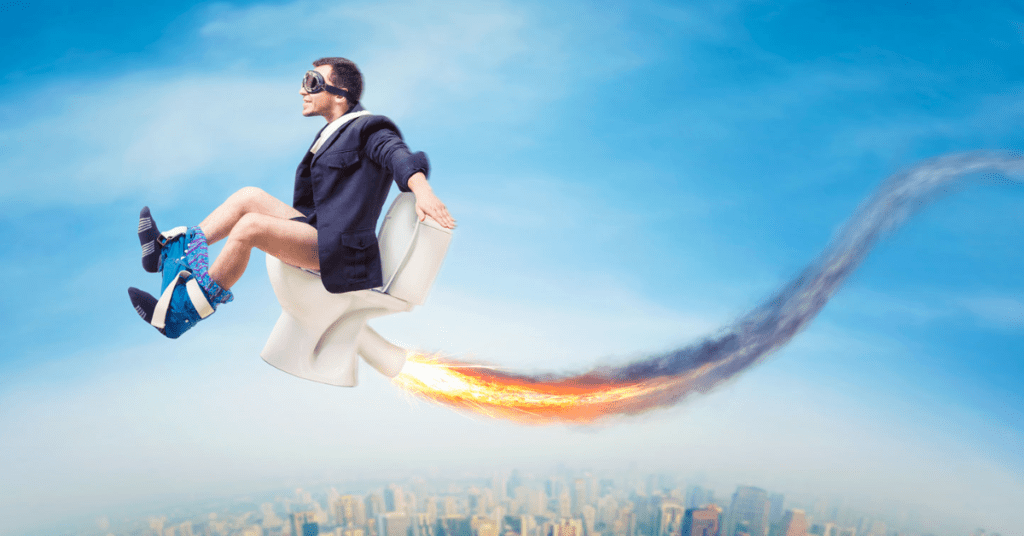This Planet Is Worth Fixing
So Let's Heal This Rock
WHOOPS PLUS SORRY EQUALS PLEASE
As we stand at a crossroads in humanity’s story thus far, Earth has certainly served as both cradle and crucible, shaped by our ingenuity even as it compels us to rethink our future.
To make sense of our planetary track record, I’ll go through our five-term planet management equation: WHOOPS + PLUS + SORRY = EQUALS PLEASE.
It reframes humanity’s ecological footprint as an operational ledger, one revealing misallocated resources, strategic short-sightedness and an uncanny knack for environmental re-engineering.
Let’s not be too hard on ourselves. Earth is our first crack at planetary management. It’s not as if anyone handed us a operations and maintenance manual or enrolled us into a five-day planet stewardship course before we magically showed up.
Yes, we’ve favored short-term wins, fumbled a few ecosystems, and reshaped a biosphere faster than previously thought possible but let’s not overlook that in doing so, we’ve prototyped the mechanics of interstellar living for humans.
Below are our framework’s five main components:
1. WHOOPS (Warranted Hesitation Over Operational Procedural Shortfalls)—a catalog of our ecosystemic missteps.
2. PLUS (Paradoxical, Limited, Unfinished, Self-interested)—the psychological constants steering our decisions.
3. SORRY (Scope Of Retrospective Rectification Yardsticks)—the documentation of reactive contingency systems.
4. EQUALS (Entropy Quotient Unleashed, Anthropocene Logoff Sequence)—the cumulative outcomes written across air, water, and biodiversity.
5. PLEASE (Planet Life Ending And Subsequent Evacuation)—the blueprint for off-world alternatives already in motion.
Behind the blunders lies surprising operational efficiency: planetary changes once forecasted over millennia have unfolded in decades, a 99.9% acceleration thanks to our industrial prowess.
Whether or not these results impress everyone, there’s no denying we did the work. And with our SORRY protocols formalized and approved, we’ve institutionalized a kind of retrospective accountability.
Now, as we tally up the actuals versus planned intentions, we reflect on the PLUS biases that drive both brilliance and what some negative Nelly’s might call catastrophe.
On the horizon, very cool adventures await us: lunar bases, Martian terraforming and orbital habitats. Some of these things we might never have dreamt up if we managed this planet perfectly. So yes, ok, we’ve made mistakes but perhaps Earth was always meant to be our sandbox for species-scale experimentation.
This page takes a deep dive into the planet management equation. If you thought Earth was the finale, think again, it was merely the launch site for the next round of cosmic adventures/misadventures.
1.0 WHOOPS: Warranted Hesitation Over Operational Procedural Shortfalls.
Humans prefer euphemisms for our mistakes. We don’t “fail catastrophically”—we experience “Warranted Hesitation Over Operational Procedural Shortfalls.” Since sharing Earth with its native flora and fauna, we’ve accumulated quite a portfolio of WHOOPS-ies:
We prioritized profit over planet preservation, called ruin “progress,” and treated warnings as noise. We transformed rainforests into deserts for cheap products, watched oceans choke and forests burn, then shrugged. We treated nature like infinite credit, overdrafting life to extinction while leaving behind poisoned waters, thinning ice, and air unfit to breathe.
1.1 Earth Based Humans Greatest Hits Collection:
1. Environmental Destruction: The Amazon became cattle ranches, triggering desertification. Palm oil plantations replaced biodiverse Southeast Asian forests with monocultures. We drained Mississippi wetlands, eliminating flood buffers, and converted North American prairies to agriculture, disrupting carbon-storing native grasses.
2. Resource Pollution: We created the Great Pacific Garbage Patch, turned Indonesia’s Citarum River toxic, and generated agricultural runoff that formed hypoxic “dead zones” in the Gulf of Mexico. Acid rain from our emissions killed forests and acidified lakes while persistent organic pollutants bioaccumulated up food chains.
3. Species Extinction: North Atlantic cod collapsed from overfishing, passenger pigeons vanished despite numbering in billions, and orangutans face extinction from Borneo’s clear-cutting. We’ve pushed countless species toward oblivion through overexploitation, habitat destruction, and wildlife trafficking.
4. Historical “Progress”: The Industrial Revolution taught us to grow “as much, as fast, and as far as possible,” generating massive carbon emissions, pollution, and habitat destruction. America’s Manifest Destiny rationalized the “tradition of waste,” contributing directly to the devastating Dust Bowl of the 1930s.
1.2 The Anthropocentric Foundation.
At our core lies anthropocentrism, a worldview placing humans at the universe’s center, prioritizing our needs above all other entities.
This perspective shapes environmental policies by prioritizing economic growth over protection, focusing on human well-being as the primary goal, and ignoring the intrinsic value of non-human life.
The consequences manifest as systematic overexploitation of resources, habitat destruction through infrastructure projects, ecosystem disruption, biodiversity loss, and delayed climate action despite devastating impacts.
1.3 Intergenerational Debt.
Perhaps our greatest WHOOPS is failing future generations. We’ve accumulated massive “intergenerational debt,” deferring environmental costs to those yet born while violating the principle that current generations should meet their needs without compromising future generations’ ability to meet theirs.
Future generations inherit environmental degradation, resource scarcity, accumulated pollution and climate vulnerability, a tangible burden passed down through our collective failure to govern with long-term perspective.
2.0 PLUS: The Human Equation.
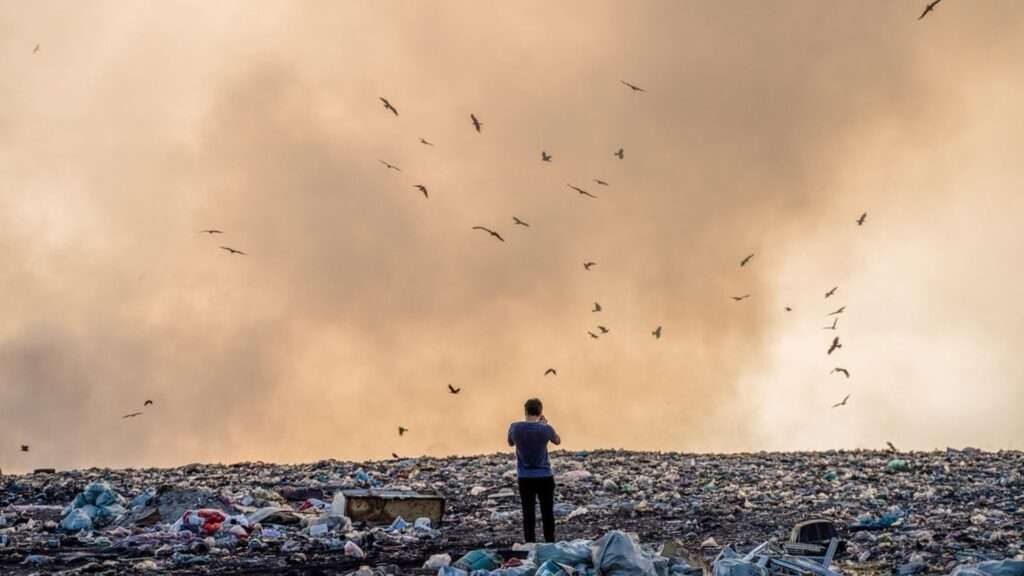
Understanding our many WHOOPS’ies requires examining what makes us human. P.L.U.S. represents our fundamental nature:
P—Paradoxical: We dream of peace yet we seem to thrive on conflict, invent cures while creating pollutants, seek truth while spinning fictions. We invented plastic for convenience, then buried ecosystems in it. We celebrated industrial revolutions while eroding natural evolution.
L—Limited: In foresight, empathy, and time—we act as if infinite when our choices echo in a finite world. We focused on quarterly profits, not generational impacts. We believed nature’s resilience was limitless and struggled to grasp slow-moving disasters until they accelerated.
U—Unfinished: Always evolving, rarely arriving. Our ideas and ethics are patchworks in progress. We adopted fossil fuels before knowing how to quit them, chose convenience over sustainability, and failed to complete the ethical leap from dominion to stewardship.
S—Self-interested: Capable of cooperation but prone to tribalism. We serve causes until comfort whispers a detour. We treated forests as profit sheets, valued luxury over biodiversity, and chose short-term comfort over long-term climate stability.
2.1 Current Priorities: The FLEM Problem.
Rather than addressing homelessness affecting millions of and getting rid of landfill rubbish operations once and for all, we’ve identified a far more critical threat to the continuation of this planet: Four Legged Emitters of Methane (FLEM), formerly known as cows. These creatures pump planet-destroying methane into our atmosphere, requiring urgent intervention.
Our brightest minds have devised brilliant solutions: seaweed supplements reducing emissions by 98%, vaccines against methanogens, genetic breeding programs, and precision feeding systems. With sufficient billions invested, we’ll surely solve this FLEM crisis while those questioning our priorities can rest assured folks, we’re handling the important stuff.
3.0 SORRY: Scope Of Retrospective Rectification Yardsticks.
Our exceptional intelligence drives us to devise backup plans for all actions, just in case we make mistakes.
I don’t believe humans will ever make a mistake, but we maintain comprehensive SORRY protocols just in case.
SORRY allows us to immerse ourselves in our work without being bogged down by details like “long-term consequences” or “habitability for future generations.”
The SORRY framework represents the pinnacle of human foresight: a comprehensive system acknowledging potential problems while simultaneously doing nothing about them.
It’s bureaucratic poetry in motion, testament to our ability to create elaborate infrastructure around deniable responsibility.
3.1 SORRY Risk Management.
Our environmental modification project consistently exceeds projected timelines. Scientists estimated planetary changes would require millennia; through innovative industrial production, transportation, and agriculture, we’ve compressed this to mere decades, a triumph of efficiency and humans rolling up their sleeves and doing the hard work.
Every challenge strengthens our problem-solving capabilities. Rising sea levels prompt advances in aquatic architecture.
Extreme weather drives climate-controlled environment innovation. Species extinction accelerates synthetic biology development.
Rather than viewing these as problems requiring solutions, we’ve reframed them as opportunities for growth and learning.
In a nutshell, we can do pretty much whatever we want, as long as we’ve got a sorry prepared.
4.0 EQUALS: Entropy Quotient Unleashed, Anthropocene Logoff Sequence.
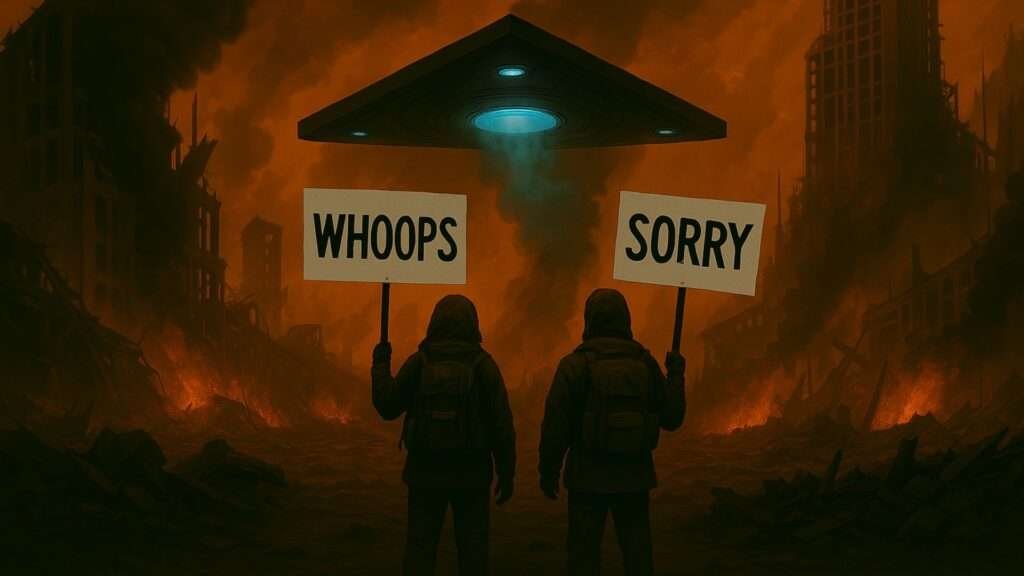
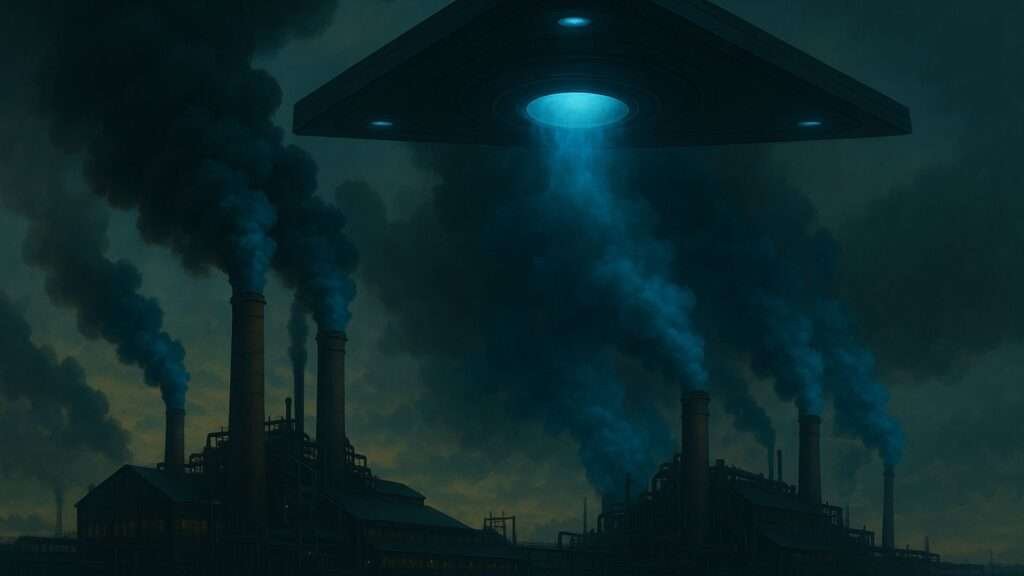
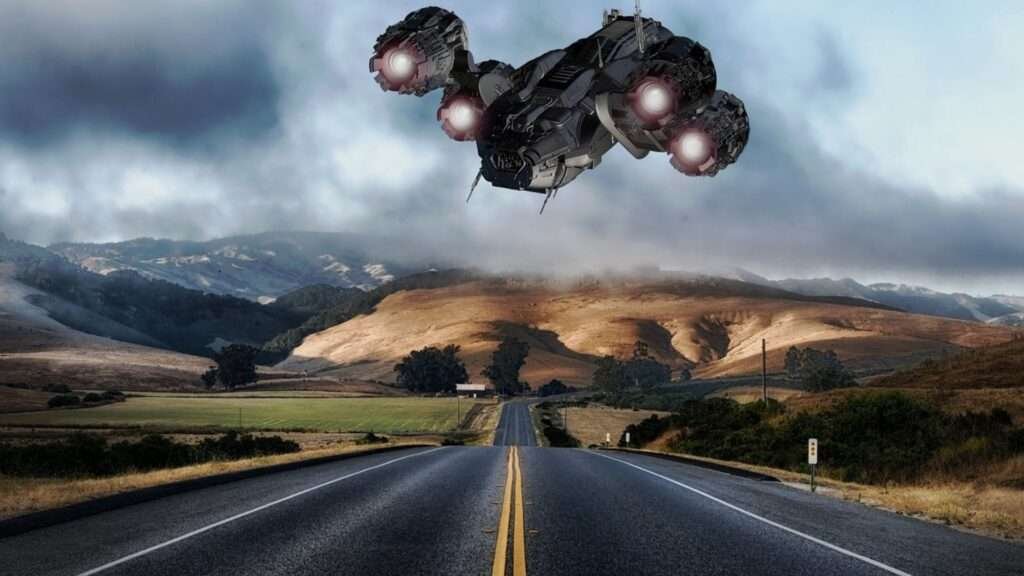
E.Q.U.A.L.S. represents the very interesting 4th part of the equation, what our WHOOPS PLUS SORRY ultimately produces:
E—Entropy Escalated: We tipped planetary thermodynamic balance. Low entropy biosphere became high entropy garbage patch.
Q—Quorum Quashed: Consensus dissolved in cognitive bias. Rational policy lost to tribal noise.
U—Unsustainability Uncoded: We reverse-engineered our survival logic and found an infinite loop of extraction minus regeneration.
A—Anthropocentric Algorithms: Every model skewed toward human benefit, no matter how many Earth variables were nullified.
L—Labile Landscapes: Once stable biomes now behave like stochastic systems—tipping points breached, feedback loops screaming.
S—Stellar Migration: We’re trading Earth for exoplanets, not because we solved gravity, but because we failed to solve greed.
4.1 The Alien Oversight Theory.
Naturally, this isn’t entirely our fault. Advanced extraterrestrial and inter-dimensional civilizations clearly must take some responsibility for proper planetary stewardship guidance not taking place here on Earth.
They possess superior entropy understanding, zero-point energy technology, gravity manipulation, greater than light speed travel multi dimensional planet health forecasting tools while we struggled with VisiCalc, Lotus 1-2-3, Multiplan and Microsoft Excel.
At a time in our development where we were trying to develop a mouse trap, they were apparently communicating with us via neutrino pulses and we misread them as “vibes”, how the heck were we supposed to know this?
Their advisory memos were via quantum entanglement, something our email inboxes weren’t able to receive.
They encoded terraforming tips in Fibonacci spirals, but back in the old days, none of our math teachers ever covered that curriculum.
The aliens watched our biosphere unravel, let us pump toxins into the air for for a very long time without protest and maintained galactic Prime Directive silence while we flailed.
They didn’t just observe the disaster named Earth, they produced it through benign neglect, it’s their fault, not ours.
5.0 PLEASE: Planet Life Ending And Subsequent Evacuation.
Should a PLEASE event occur, our SORRY protocols ensure humanity has delightful alternatives ready for immediate deployment:
Phase 1: Lunar Hospitality Suites offer luxury 6 star resort charm with stunning gray vistas and profound silence. We’ll be able to house at least 50,000 humans in underground facilities, assuming everyone shares bunks and doesn’t mind complete absence of breathable atmosphere, natural water, or edible vegetation.
Phase 2: Mars Real Estate Development provides exciting opportunities to experience what Earth might have been like if designed by someone with no imagination and profound dislike of warmth. Our modest terraforming timeline requires only 500 years to achieve basic habitability, assuming of course that our attempts at this actually work.
Phase 3: O’Neill Cylinder Communities represent ultimate housing innovation: living inside giant spinning tubes hurtling through the void. Think exclusive gated communities where HOA fees include oxygen recycling and the neighbours are selected for psychological stability in enclosed spaces.
Phase 4: Generation Ship Expeditions feature massive vessels supporting human life during leisurely 1,000-year journeys to potentially habitable exoplanets. These ships will hopefully include all modern amenities: recycled air, processed protein, and entertainment systems with every movie ever made.
Phase 5: Digital Consciousness Transfer this will allow human consciousness to be uploaded to quantum servers, where we can live forever in virtual reality while physical forms become unnecessary. No more diets or exercise for us, it’s the ultimate insurance: even if we destroy every planet we touch, we’ll be able to retreat into simulated worlds where climate is perfect and the phone and internet providers never fail to deliver.
5.1 Strategic Communications.
We’ve maintained remarkable public confidence throughout this ambitious environmental transformation project.
Despite occasional sensationalist media coverage and alarmist scientific reports, humanity remains committed to our shared vision of unlimited growth and consumption.
Our communications team positions environmental changes not as problems, but as evidence of human capability.
Melting glaciers demonstrate our power to alter geological processes millions of years old. Unprecedented weather patterns prove our ability to influence global atmospheric systems.
5.2 What Could Possibly Go Wrong?
As we stand on the threshold of humanity’s next chapter, Earth and humankind have rewritten each other’s story.
This planet made us masters of global transformation and in turn, we’ve shaped it into a realm that now demands our exodus.
It’s a perfect symbiosis: we engineered the very crisis that propels our departure, even as we hone the tools to carry it out.
In the decades ahead, when the final evacuation ships lift off, we’ll glance back with fond nostalgia, graduating from our cosmic alma mater.
Earth will have served as training ground, experimental lab, and proof of concept for ventures among the stars.
Skeptics need only remember that the SORRY protocols and PLEASE contingencies are locked and loaded. Our next chapter promises feats even more spectacular than anything this world has seen.
After all, what could possibly go wrong?
Let's Get Involved With Fixing This Planet
Readers Most Enjoyed Articles.
The MAYBE Strategy: Humanity’s Cosmic Backup Plan.
So, Earth’s a bit of a mess, isn’t it, yeh I know. The climate’s a bit wobbly like it’s been partying all night, the oceans are a tad grumpy now that we’ve removed most of it’s native marine inhabitants and replaced that space with waste plastics and the polar bears are sending us passive-aggressive postcards as they have to keep moving home each year as homes are melting.
But fear not, people! We’ve got a strategy to excuse our planetary fumbles, it’s MAYBE.
This isn’t just a word; it’s a strategy, a cheeky wink at the universe, saying, “We’ve got a few options on the table ol’ mate.”
This is what it’s all about.
M is for Moon.
Our dusty neighbor’s been eyeing us like a quiet Airbnb host, ready to take us in when we’ve trashed our own place. Lunar bases? We’re already sketching floor plans for chic moon condos. Low gravity means epic basketball dunks, and the view’s not bad either. Earth’s a fixer-upper gone wrong? No worries, we’ll just moonwalk away.
A stands for Asteroids.
Why fix one planet when you can mine a floating rock? Asteroids are bursting with resources—think cosmic vending machines. We’ll drill, baby, drill, and fund our spacefaring dreams. Earth’s resources running low? Pfft, we’ll just snag a space boulder and call it a day.
Y is for Yonder, as in O’Neill cylinders.
These spinning space habitats are like cosmic hamster wheels, but fancier. Picture utopian neighborhoods twirling in orbit, with artificial gravity and zero HOA fees. Earth’s too crowded? Yonder’s got room for your quirky art projects and pet llamas.
B brings us to Bases on Mars.
Elon’s been tweeting about it for years, and we’re halfway to packing our bags and getting checked in at his Starbase as he fuels up the starships.
Mars has red dirt, cool canyons, and no traffic jams. Sure, it’s a bit chilly, but we’ll knit some spacesuits and terraform a vineyard. Earth’s toast? Mars is our rustic Plan B.
E is for Earth-Orbiting Hotels.
Why commit to one planet when you can sip cosmic cocktails in a swanky space station? These orbiting resorts will have zero-G pools and Instagram-worthy views of Earth’s tantrums. If our home planet’s a write-off, we’ll just check into the penthouse suite in orbit.
So, relax, everyone! MAYBE is our get-out-of-jail-free card.
Earth was our first stab at planet management and well, we winged it.
If it all goes pear-shaped, we’ve got the Moon, asteroids, yonder cylinders, Martian bases, and space hotels ready to save our bacon.
After all, who needs a perfect Earth when the cosmos is our backup plan?
1. We will Colonize the Moon - Maybe?
2. We will Colonize Mars- Maybe?
4. We will live in monstrous Space Stations around the Planet - Maybe?
5. Develop near light speed travel & colonize Proxima Centauri B - Maybe?
So as you can see my fellow Humans, we have got nothing to worry about, go about your lives, do whatever you want, when you want and just remember to keep a bag packed in case you’re name is called out when the its time for a SORRY.
It is either us or the planet, isn't it?
Contact Us
We're Ready, Let's Talk.
Contact Info
Address
PO Box 784, Muswellbrook, NSW, Australia
Email Us
admin@healthisrock.com










